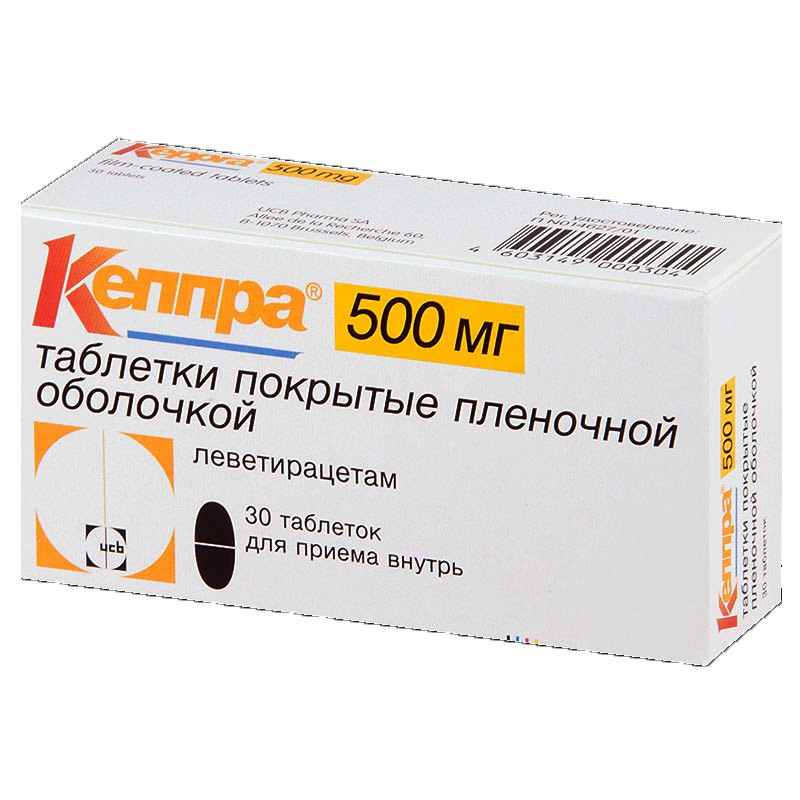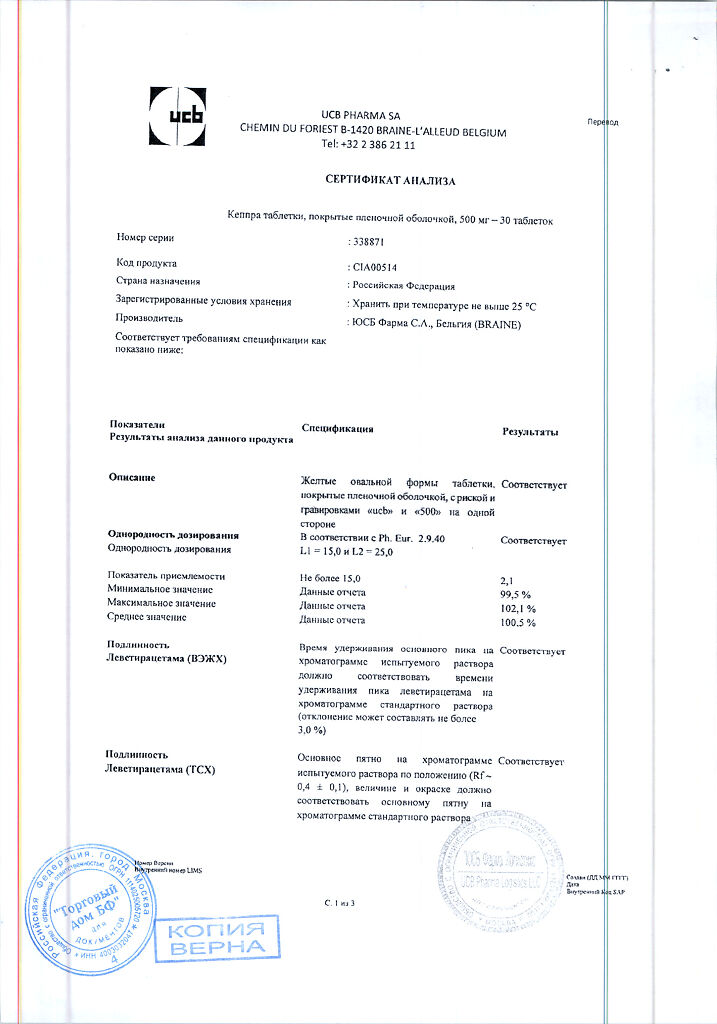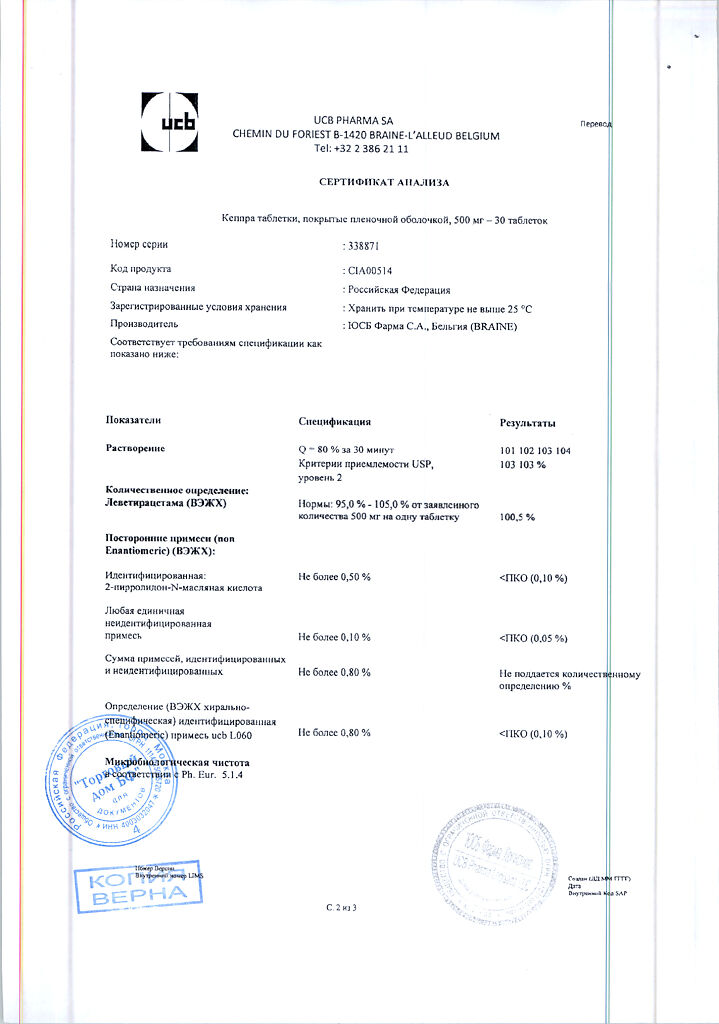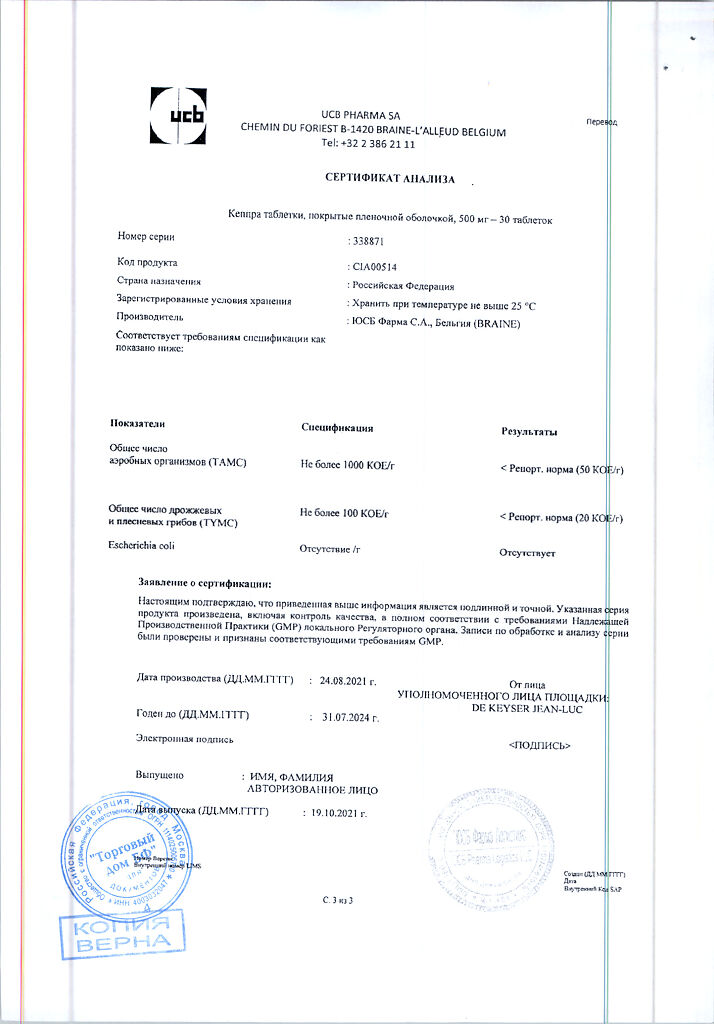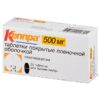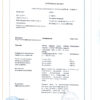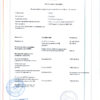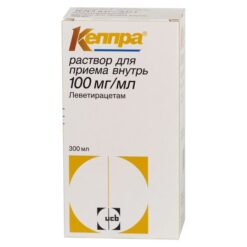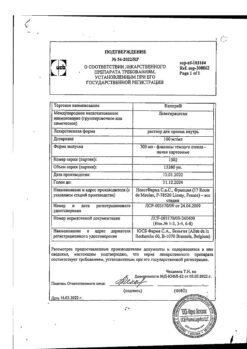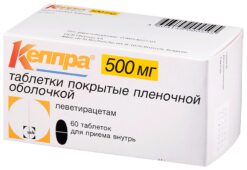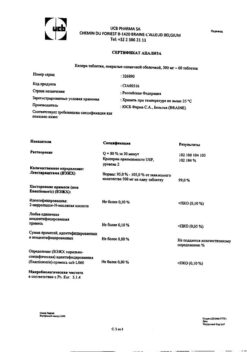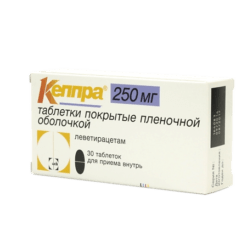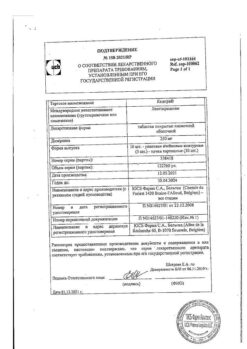No products in the cart.
Keppra, 500 mg 30 pcs.
€28.64 €24.82
Description
The antiepileptic drug, a pyrrolidone derivative (S-enantiomer of α-ethyl-2-oxo-1-pyrrolidine acetamide), differs from most known antiepileptic drugs by its chemical structure. The study of the mechanism of action of levetiracetam has not yet been completed, but it is clear that it differs from the mechanism of action of known antiepileptic drugs.
The results of an in vitro study showed that levetiracetam affects the intraneuronal concentration of Ca2+ ions by partially inhibiting Ca2+ flow through N-type channels and reducing the release of calcium from intraneuronal depots. In addition, levetiracetam partially restores currents through GABA- and glycine-dependent channels reduced by zinc and β-carbolines.
One putative mechanism is based on proven binding to the glycoprotein of synaptic vesicles SV2A, found in the gray matter of the brain and spinal cord. It is assumed that this is how the anticonvulsant effect is realized, which is expressed in the counteraction of hypersynchronization of neuronal activity. It does not alter normal neurotransmission, but suppresses epileptiform neuronal bursts induced by the GABA agonist bicuculline and excitation of glutamate receptors. The activity of the drug has been confirmed against both focal and generalized epileptic seizures (epileptiform manifestations/photoparoxysmal response).
Pharmacokinetics
Absorption
Levetiracetam is well absorbed from the GI tract after oral administration. Absorption is complete and linear, so plasma concentrations can be predicted based on the applicable dose of the drug in mg/kg body weight. The degree of absorption is independent of the dose and time of ingestion. Bioavailability is about 100%.
After 1 g dose the Cmax in plasma is reached after 1.3 h and is 31 mcg/ml, after repeated administration (2 times/day) – 43 mcg/ml.
Distribution
The equilibrium state is reached after 2 days with twice-daily administration of the drug. Binding to plasma proteins of levetiracetam and its main metabolite is less than 10%. Vd of levetiracetam is about 0.5-0.7 l/kg.
Metabolism
The formation of the primary pharmacologically inactive metabolite (ucb L057) occurs without the participation of cytochrome P450 isoenzymes in the liver. Levetiracetam does not affect the enzymatic activity of hepatocytes.
In adults T1/2 from blood plasma is 7±1 h and does not change depending on the dose, method of administration or repeated administration. Mean clearance is 0.96 ml/min/kg. 95% of the dose is excreted by the kidneys. Renal clearance of levetiracetam and its inactive metabolite is 0.6 ml/min/kg and 4.2 ml/min/kg, respectively.
Pharmacokinetics in special clinical cases
In elderly patients, T1/2 is increased by 40% and is 10-11 h, which is associated with decreased renal function in this population.
In patients with impaired renal function, the clearance of levetiracetam and its primary metabolite correlates with creatinine clearance. Therefore, in patients with renal impairment, it is recommended that the dose be adjusted according to the CKR. In end-stage renal failure in adult patients the T1/2 is 25 h between dialysis sessions and 3.1 h during dialysis. Up to 51% of levetiracetam is removed during a 4-hour dialysis session.
In a 4-hour dialysis session, 51% of levetiracetam is removed from the body.
In patients with mild to moderate hepatic impairment there is no significant change in the clearance of levetiracetam. In severe hepatic impairment with concomitant renal failure, the clearance of levetiracetam is reduced by more than 50%.
The pharmacokinetics of levetiracetam in children is linear in the dose range from 20 to 60 mg/kg/day. Cmax is reached after 0.5-1 hours. T1/2 in children after a single oral dose of 20 mg/kg body weight is 5-6 hours. Total clearance of levetiracetam in children is about 40% higher than in adults and is in direct relation to body weight.
Indications
Indications
As monotherapy (drug of first choice) in the treatment of:
partial seizures with or without secondary generalization in adults and adolescents over 16 years of age with newly diagnosed epilepsy.
As part of complex therapy for the treatment of:
partial seizures with or without secondary generalization in adults and children over 4 years of age suffering from epilepsy (for tablets);
partial seizures with or without secondary generalization in adults and children over 1 month suffering from epilepsy (for solution);
myoclonic seizures in adults and adolescents over 12 years of age with juvenile myoclonic epilepsy;
primary generalized convulsive (tonic-clonic) seizures in adults and adolescents over 12 years of age with idiopathic generalized epilepsy.
Pharmacological effect
Pharmacological effect
An antiepileptic drug, a derivative of pyrrolidone (S-enantiomer of α-ethyl-2-oxo-1-pyrrolidine-acetamide), differs in chemical structure from most known antiepileptic drugs. The mechanism of action of levetiracetam has not yet been studied, but it is clear that it differs from the mechanism of action of known antiepileptic drugs.
The results of an in vitro study showed that levetiracetam affects the intraneuronal concentration of Ca2+ ions, partially inhibiting Ca2+ current through N-type channels and reducing the release of calcium from intraneuronal stores. In addition, levetiracetam partially restores currents through GABA- and glycine-dependent channels reduced by zinc and β-carbolines.
One of the proposed mechanisms is based on proven binding to the synaptic vesicle glycoprotein SV2A, contained in the gray matter of the brain and spinal cord. It is assumed that this is how the anticonvulsant effect is realized, which is expressed in counteracting the hypersynchronization of neural activity. Does not alter normal neurotransmission, but suppresses epileptiform neuronal bursts induced by the GABA agonist bicuculline and excitation of glutamate receptors. The activity of the drug has been confirmed against both focal and generalized epileptic seizures (epileptiform manifestations/photoparoxysmal reaction).
Pharmacokinetics
Suction
After oral administration, levetiracetam is well absorbed from the gastrointestinal tract. Absorption is complete and linear, so plasma concentrations can be predicted based on the administered dose of the drug in mg/kg body weight. The degree of absorption does not depend on the dose and time of food intake. Bioavailability is about 100%.
After taking the drug in a dose of 1 g, Cmax in the blood plasma is reached after 1.3 hours and is 31 mcg/ml, after repeated dosing (2 times/day) – 43 mcg/ml.
Distribution
An equilibrium state is achieved after 2 days with a double dose of the drug. Plasma protein binding of levetiracetam and its main metabolite is less than 10%. Vd of levetiracetam is about 0.5-0.7 l/kg.
Metabolism
The formation of the primary pharmacologically inactive metabolite (ucb L057) occurs without the participation of cytochrome P450 isoenzymes in the liver. Levetiracetam does not affect the enzymatic activity of hepatocytes.
Removal
In adults, T1/2 from blood plasma is 7±1 hours and does not change depending on the dose, route of administration or repeated administration. The average clearance is 0.96 ml/min/kg. 95% of the dose is excreted by the kidneys. The renal clearance of levetiracetam and its inactive metabolite is 0.6 ml/min/kg and 4.2 ml/min/kg, respectively.
Pharmacokinetics in special clinical situations
In elderly patients, T1/2 increases by 40% and is 10-11 hours, which is associated with a decrease in renal function in this category of people.
In patients with impaired renal function, the clearance of levetiracetam and its primary metabolite correlates with creatinine clearance. Therefore, in patients with renal failure, dose selection is recommended depending on QC. In end-stage renal failure in adult patients, T1/2 is 25 hours between dialysis sessions and 3.1 hours during dialysis. During a 4-hour dialysis session, up to 51% of levetiracetam is removed.
During the 4-hour dialysis process, 51% of levetiracetam is removed from the body.
In patients with mild to moderate liver dysfunction, there are no significant changes in the clearance of levetiracetam. In severe liver dysfunction with concomitant renal failure, the clearance of levetiracetam is reduced by more than 50%.
The pharmacokinetics of levetiracetam in children is linear in the dose range from 20 to 60 mg/kg/day. Cmax is reached after 0.5-1 hour. T1/2 in children after a single oral dose of 20 mg/kg body weight is 5-6 hours. The total clearance of levetiracetam in children is approximately 40% higher than in adults and is directly dependent on body weight.
Special instructions
Special instructions
If you need to stop taking the drug, it is recommended to discontinue it gradually, reducing the single dose by 500 mg every 2-4 weeks. In children, the dose reduction should not exceed 10 mg/kg body weight 2 times a day every 2 weeks.
It is advisable to gradually discontinue concomitant antiepileptic drugs (during the period of transfer of patients to levetiracetam).
For patients with kidney disease and decompensated liver disease, a kidney function test is recommended before starting treatment. If renal function is impaired, dose adjustment may be required.
Due to reports of suicide, suicidal ideation and suicide attempts during treatment with levetiracetam, patients should be warned to immediately notify their physician of any symptoms of depression or suicidal ideation.
The oral solution contains maltitol, therefore, patients with fructose intolerance should not take Keppra® in the appropriate dosage form.
Use in pediatrics
Available information on the use of the drug in children does not indicate any negative effect on development and puberty. However, the long-term effects of treatment on children’s learning ability, intellectual development, growth, endocrine gland function, sexual development and fertility remain unknown.
Impact on the ability to drive vehicles and operate machinery
The effect of Keppra® on the ability to drive vehicles and operate machinery has not been specifically studied. However, due to varying individual sensitivity to the drug on the part of the central nervous system, during the treatment period it is necessary to refrain from driving vehicles and engaging in potentially hazardous activities that require increased concentration and speed of psychomotor reactions.
Active ingredient
Active ingredient
Levetiracetam
Composition
Composition
1 tablet levetiracetam dihydrochloride 500 mg
Excipients:
croscarmellose sodium,
macrogol 6000,
silicon dioxide,
magnesium stearate.
Film shell composition:
opadry 85F32004 (iron oxide yellow dye (E172), macrogol 3350, partially hydrolyzed polyvinyl alcohol, talc, titanium dioxide (E171)).
Pregnancy
Pregnancy
Adequate and strictly controlled clinical studies on the safety of levetiracetam in pregnant women have not been conducted. Animal studies have shown reproductive toxicity. Therefore, the drug should not be prescribed during pregnancy unless absolutely necessary.
Physiological changes in a woman’s body during pregnancy can affect plasma concentrations of levetiracetam, as well as other antiepileptic drugs. During pregnancy, a decrease in plasma concentrations of levetiracetam was observed. This decrease is more pronounced in the first trimester (up to 60% of the baseline concentration in the period preceding pregnancy). Treatment with levetiracetam in pregnant women should be carried out under special supervision. Interruptions in antiepileptic therapy can lead to a worsening of the disease, which can harm the health of both the mother and the fetus.
Levetiracetam is excreted in breast milk, therefore, if it is necessary to use it during lactation, breastfeeding while taking the drug is not recommended. However, if treatment with levetiracetam is necessary during breastfeeding, the risk to the child versus the benefit of treatment to the mother must be carefully weighed against the importance of feeding.
Use in children
Contraindicated: children under 4 years of age (for tablets) (the safety and effectiveness of the drug have not been established); children under 1 month of age (for solution) (the safety and effectiveness of the drug have not been established);
Contraindications
Contraindications
children under 4 years of age (for tablets) (the safety and effectiveness of the drug have not been established);
children under 1 month of age (for solution) (the safety and effectiveness of the drug have not been established);
impaired tolerance to fructose (for solution);
hypersensitivity to the components of the drug;
hypersensitivity to other pyrrolidone derivatives.
The drug should be prescribed with caution to elderly patients (over 65 years old), with liver diseases in the stage of decompensation, and renal failure.
Use in elderly patients
The drug should be prescribed with caution to elderly patients (over 65 years of age).
Side Effects
Side Effects
Possible side effects are listed below by body system and frequency of occurrence: very often (>1/10), often (>1/100,
From the side of the central nervous system: very often – drowsiness, asthenic syndrome; often – amnesia, ataxia, convulsions, dizziness, headache, hyperkinesia, tremor, imbalance, decreased concentration, memory impairment, agitation, depression, emotional lability, mood swings, hostility/aggressiveness, insomnia, nervousness, irritability, personality disorders, impaired thinking; in some cases – paresthesia, behavioral disorders, anxiety, restlessness, confusion, hallucinations, irritability, psychotic disorders, suicide, suicide attempts and suicidal intentions.
From the side of the organ of vision: often – diplopia, impaired accommodation.
From the respiratory system: often – increased cough.
From the digestive system: often – abdominal pain, diarrhea, dyspepsia, nausea, vomiting, anorexia, weight gain; in some cases – pancreatitis, liver failure, hepatitis, changes in liver function tests, weight loss.
Dermatological reactions: often – skin rash, eczema, itching; in some cases – alopecia (in some cases, hair restoration was observed after discontinuation of the drug), Stevens-Johnson syndrome, erythema multiforme, toxic epidermal necrolysis.
From the hematopoietic system: in some cases – leukopenia, neutropenia, pancytopenia (in some cases with suppression of bone marrow function), thrombocytopenia.
Other: in some cases – infections, nasopharyngitis, myalgia.
Interaction
Interaction
Levetiracetam does not interact with anticonvulsants (phenytoin, carbamazepine, valproic acid, phenobarbital, lamotrigine, gabapentin and primidone).
Levetiracetam at a daily dose of 1 g does not change the pharmacokinetics of oral contraceptives (ethinyl estradiol and levonorgestrel).
Levetiracetam at a daily dose of 2 g does not change the pharmacokinetics of warfarin and digoxin.
Digoxin, oral contraceptives and warfarin do not affect the pharmacokinetics of levetiracetam.
When taken together with topiramate, the likelihood of developing anorexia is higher.
The completeness of absorption of levetiracetam does not change under the influence of food, but the rate of absorption is slightly reduced.
There are no data on the interaction of levetiracetam with alcohol.
Overdose
Overdose
Symptoms: drowsiness, anxiety, aggressiveness, depression of consciousness, respiratory depression, coma.
Treatment: in the acute period – artificial induction of vomiting and gastric lavage, followed by the administration of activated charcoal. There is no specific antidote for levetiracetam. If necessary, symptomatic treatment is carried out in a hospital setting using hemodialysis (dialysis efficiency for levetiracetam is 60%, for its primary metabolite – 74%).
Storage conditions
Storage conditions
In a dry place, at a temperature not exceeding 25 °C
Shelf life
Shelf life
3 years in original packaging
Manufacturer
Manufacturer
UCB Farma, Belgium
Additional information
| Shelf life | 3 years in its original packaging |
|---|---|
| Conditions of storage | In a dry place, at a temperature not exceeding 25 °C |
| Manufacturer | UCB Farma, Belgium |
| Medication form | pills |
| Brand | UCB Farma |
Other forms…
Related products
Buy Keppra, 500 mg 30 pcs. with delivery to USA, UK, Europe and over 120 other countries.

